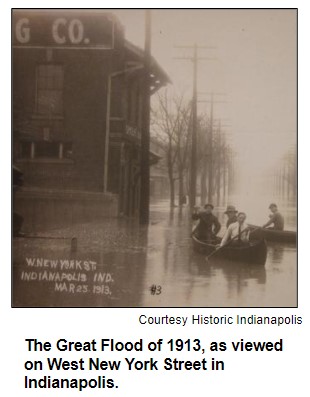Apr 30, 2021
|
Saturdays, noon to 1 p.m. ET on WICR 88.7 FM. |
|
April 17, 2021 Bear pit at Riverside Park and other bygone animal attractionsClick here to listen to the podcast.
Bears at Riverside Park in Indianapolis? Not for the last century. But for nearly two decades beginning in 1899, a bear pit was among the most popular attractions at the park near the White River.
And the Riverside bear pit, although the longest-lasting and most significant local animal attraction during the era (it even sometimes was casually referred to as a "zoo"), wasn't the only collection of wildlife on display in Indianapolis parks. The popularity of the attraction at Riverside led to a public exhibit of bears at Garfield Park beginning in 1905, according to research by attorney Ed Fujawa, who will be Nelson's guest. Monkeys also were exhibited for a few years at Garfield Park - as well as, even more briefly, at Brookside Park, where visitors also could gaze at exotic birds. Ed, the creator of the history blog Class 900: Indianapolis, has written about the Riverside bear pit. An adventure lover, Ed hiked around Riverside to find remnants of the bygone bear pit, discovering the two arched doorways for the den amid trees, rocks and brush.
Of the bygone Riverside Park bear pit, Ed Fujawa writes: "While the bears and other animals were popular with visitors, the conditions in which the animals were kept were not ideal." He describes letters of complaint in 1900 to Indianapolis newspapers. Ed elaborates on the poor treatment of park animals at the time, calling them "disgraceful, especially when compared to modern standards. The animal pens were too small, especially for the bears, and the staff of the parks often did not take action to protect the animals from outside influences, such as visitors to the park, or natural disasters." His blog post recounts floods of the nearby White River that resulted in "close calls" for the bears, who "climbed trees and logs placed in the pit to escape the encroaching water."
With his Class 900 blog, Ed focuses on unearthing Indy history that's often been overlooked or forgotten. In 2020, he was a Hoosier History Live guest for a show about tree-planting crusades in Indy that began in the 1850s. Even then, city residents were worried about the loss of tree canopy in the urban area. During the early 1900s, greenhouses at Garfield Park were used in the winter to house some of the animals from Riverside Park, including the monkeys, Ed says. Bears remained at Riverside, sheltering in their den during the winter. In 1904 the bears managed to survive a flood of the nearby White River by climbing trees and logs (Ed describes the local newspaper accounts as "heartbreaking"), but some of the smaller animals and birds at Riverside drowned. The impact on the bear pit of the Great Flood of 1913, the worst flood in Indiana history, is unclear, Ed says. When the last remaining bear at Riverside died in 1917, the animal display closed. The arched doorways of the den and other remnants of the bear pit are challenging to find today, Ed reports. "The site of the bear pit was later converted into a rock garden, which likely explains the numerous rocks spread throughout the site when I visited." Like many other Indianapolis history lovers, Ed initially learned about the bygone bear pits at the parks by discovering vintage postcards depicting them. He reports that postcards of the animal exhibits are regularly sold on ebay and other sites featuring city memorabilia. |

 Consisting of a fenced,
circular pen with two arched doorways that allowed the bears to
enter a sheltered den, the bear pit at Riverside was featured on
thousands of postcards that have become collectibles.
Consisting of a fenced,
circular pen with two arched doorways that allowed the bears to
enter a sheltered den, the bear pit at Riverside was featured on
thousands of postcards that have become collectibles. The Riverside animal
attractions - which even included deer, elk, wolves and (briefly)
two sea lions, - and at the other parks long predate what is
considered to be the first official
The Riverside animal
attractions - which even included deer, elk, wolves and (briefly)
two sea lions, - and at the other parks long predate what is
considered to be the first official  According to Ed, a female
bear at Garfield Park named Minnie died in 1905 after being fed
buckeyes by the public. Local newspapers speculated that buckeyes
were poisonous to the bear.
According to Ed, a female
bear at Garfield Park named Minnie died in 1905 after being fed
buckeyes by the public. Local newspapers speculated that buckeyes
were poisonous to the bear.